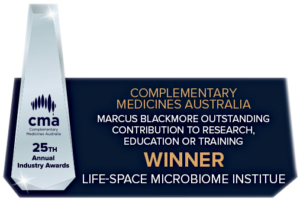CFU: CFU stands for ‘Colony Forming Unit’ – a globally recognised term used to describe the number of viable cells or live bacteria found in a probiotic supplement. The CFU measurement identifies the dose of individual probiotics and should therefore be listed per probiotic strain or species within the supplement. The CFU measurement assists with identifying the dose and therefore potential health benefits. (1)
Dysbiosis: A compositional and functional alteration in the microbiota that is driven by environmental and host-related factors that perturb the microbiome to an extent that overwhelms resistance factors. A true state of dysbiosis should take into account normal inter-individual variability, such as age, gender, geographic location and race, and should be sufficient to manifest as disease states. (2)
Lyophilisation: Freeze-drying, often referred to as lyophilisation, is a method that uses freeze drying under low pressure and evaporation to remove water from a substance. The goal of lyophilisation is to slowly remove water content from a substance for its preservation. (3) In terms of probiotics, lyophilisation needs to be combined with cryo-protectants to help prevent damage to the cell membrane of bacteria during the drying process. Cryo-protectants consist of simple compounds of glycerol, sugars, or polymers. (4)
Biotics: Biotic refers to the living components or factors within an ecosystem. These include all organisms such as plants, animals, fungi, bacteria, and other microorganisms. Biotic factors interact with abiotic (non-living) factors like temperature, water, and soil to create complex ecological systems. (5)
Eubiosis: Eubiosis is a term that refers to a state of balanced, healthy living within an organism or ecosystem, characterised by a harmonious relationship between different organisms and their environment. It is the opposite of dysbiosis, which signifies an imbalance or unhealthy state. Eubiosis is often used in the context of the human gut microbiome, where a diverse and balanced community of microorganisms contributes to overall health. (6)
Pathobiont: A pathobiont is a microorganism that is typically harmless when present in low numbers but can become pathogenic or disease-causing when its population increases or when it interacts with other factors that disrupt the balance of the host’s microbiome. Pathobionts are often opportunistic pathogens, taking advantage of conditions that weaken the host’s immune system or alter the local environment, leading to infections or disease. (7)
Commensal: Commensal bacteria are microorganisms, typically bacteria, that live in or on the body of a host organism without causing harm or benefiting it. These bacteria have a neutral relationship with their host and may even provide some benefits, such as aiding in the digestion of food or preventing the colonisation of harmful pathogens. Commensal bacteria are a part of the normal flora or microbiota of an organism. (8,9)
Microbiota: The term “microbiota” refers to the community of microorganisms, including bacteria, fungi, viruses, and other microbes, that inhabit a specific environment or host, such as the human body, a plant, or a specific ecosystem. Microbiota play a crucial role in various biological processes, including digestion, immune system function, and protection against pathogenic invaders. (10)
Fermented food: Fermented foods are defined as foods that have undergone enzymatic reactions in response to microorganisms, typically bacteria or yeast and are made up of various health promoting properties, including nutrients, prebiotics, probiotics and microbial metabolites. Fermented foods can be made from multiple food sources, such as dairy, grains, vegetables, fruits, meats, fish and legumes, with some common examples including kefir, kombucha, wine, sauerkraut, miso, yogurt and sourdough bread. (11,12)
Gut-Skin Axis: The ‘gut-skin axis’ refers to the bidirectional relationship between the gut microbiome and skin health. The gut microbiome’s influence reaches beyond the gut and supports the function of other organs. One such organ influenced by the gut microbiome is the skin, the largest organ of the human body. The gut and the skin are both important for healthy immune system function, being uniquely connected with the external environment and with one another by purpose and function. (13)
Gut-Brain Axis: The ‘gut-brain axis’ is a bidirectional communication system that connects the central nervous system (the brain and spinal cord) with the enteric nervous system in the gastrointestinal tract. This communication system involves neurons of the sympathetic and parasympathetic nervous systems, as well as hormonal, and immunological signalling, allowing the gut and the brain to interact and influence each other. The vagus nerve, a prominent component of the ‘gut-brain’ axis, plays a critical role in transmitting sensory information from the gut to the brain and facilitating the brain’s regulation of gut functions. (14,15)
Gut-Heart Axis: The ‘gut-heart axis’ is an emerging concept in medical research that highlights the bidirectional relationship between the gut, specifically the gut microbiota, and the cardiovascular system, including the heart and blood vessels. This concept suggests that the health and composition of the gut microbiota can influence cardiovascular health, and conversely, the cardiovascular system can impact the gut. (16) Some of the ways in which the microbiome can influence cardiovascular health are by the production and regulation of metabolites and enzymes, including short chain fatty acids (SCFA), bile salt hydrolase and trimethylamine oxidase (TMAO). (17)
References
- Office of Dietary Supplements – Probiotics [Internet]. [cited 2023 Nov 2]. Available from: https://ods.od.nih.gov/factsheets/Probiotics-HealthProfessional/
- Levy M, Kolodziejczyk AA, Thaiss CA, Elinav E. Dysbiosis and the immune system. Nat Rev Immunol. 2017 Apr;17(4):219–32.
- Nowak D, Jakubczyk E. The Freeze-Drying of Foods—The Characteristic of the Process Course and the Effect of Its Parameters on the Physical Properties of Food Materials. Foods [Internet]. 2020 Oct [cited 2023 Jul 19];9(10). Available from: https://www.ncbi.nlm.nih.gov/pmc/articles/PMC7603155/
- Govender M, Choonara YE, Kumar P, du Toit LC, van Vuuren S, Pillay V. A Review of the Advancements in Probiotic Delivery: Conventional vs. Non-conventional Formulations for Intestinal Flora Supplementation. AAPS PharmSciTech. 2013 Sep 25;15(1):29–43.
- Smith, Thomas S Robert Leo. Elements of Ecology. 8th ed. Pearson Benjamin Cummings; 2012.
- Iebba V, Totino V, Gagliardi A, Santangelo F, Cacciotti F, Trancassini M, et al. Eubiosis and dysbiosis: the two sides of the microbiota. New Microbiol. 2016 Jan;39(1):1–12.
- Kamada N, Seo SU, Chen GY, Núñez G. Role of the gut microbiota in immunity and inflammatory disease. Nat Rev Immunol. 2013 May;13(5):321–35.
- Glossary [Internet]. [cited 2023 Nov 2]. Available from: https://internationalprobiotics.org/home/resources/glossary/
- Guarner F, Malagelada JR. Gut flora in health and disease. Lancet Lond Engl. 2003 Feb 8;361(9356):512–9.
- Jandhyala SM, Talukdar R, Subramanyam C, Vuyyuru H, Sasikala M, Reddy DN. Role of the normal gut microbiota. World J Gastroenterol WJG. 2015 Aug 7;21(29):8787–803.
- Eirini, Dimidi, Selina, Rose, Cox, Megan, Rossi, Kevin, Whelan. Fermented Foods: Definitions and Characteristics, Impact on the Gut Microbiota and Effects on Gastrointestinal Health and Disease – PubMed. Nutrients [Internet]. [cited 2023 Nov 3]; Available from: https://pubmed.ncbi.nlm.nih.gov/31387262/
- International Scientific Association for Probiotics and Prebiotics (ISAPP) [Internet]. [cited 2023 Nov 3]. Fermented Foods. Available from: https://isappscience.org/for-consumers/learn/fermented-foods/
- O’Neill CA, Monteleone G, McLaughlin JT, Paus R. The gut-skin axis in health and disease: A paradigm with therapeutic implications. BioEssays News Rev Mol Cell Dev Biol. 2016 Nov;38(11):1167–76.
- Sanders ME. International Scientific Association for Probiotics and Prebiotics (ISAPP). 2017 [cited 2023 Nov 3]. Bugs on the Brain: the Microbiota-Gut-Brain Axis. Available from: https://isappscience.org/bugs-brain-microbiota-gut-brain-axis/
- Cryan JF, Dinan TG. Mind-altering microorganisms: the impact of the gut microbiota on brain and behaviour. Nat Rev Neurosci. 2012 Oct;13(10):701–12.
- Ahlawat S, Asha null, Sharma KK. Gut-organ axis: a microbial outreach and networking. Lett Appl Microbiol. 2021 Jun;72(6):636–68.
- Rahman MdM, Islam F, -Or-Rashid MdH, Mamun AA, Rahaman MdS, Islam MdM, et al. The Gut Microbiota (Microbiome) in Cardiovascular Disease and Its Therapeutic Regulation. Front Cell Infect Microbiol [Internet]. 2022 [cited 2023 Apr 17];12. Available from: https://www.frontiersin.org/articles/10.3389/fcimb.2022.903570

